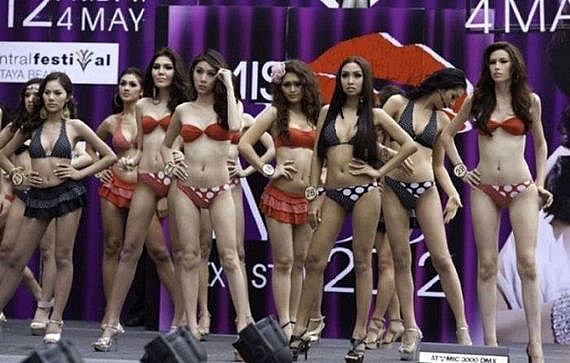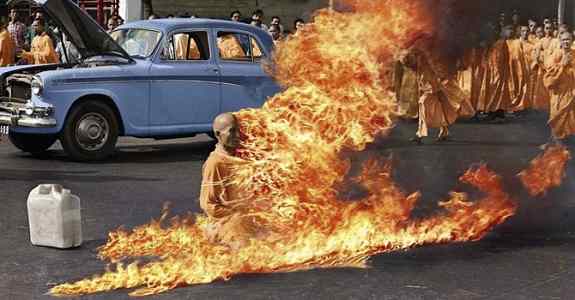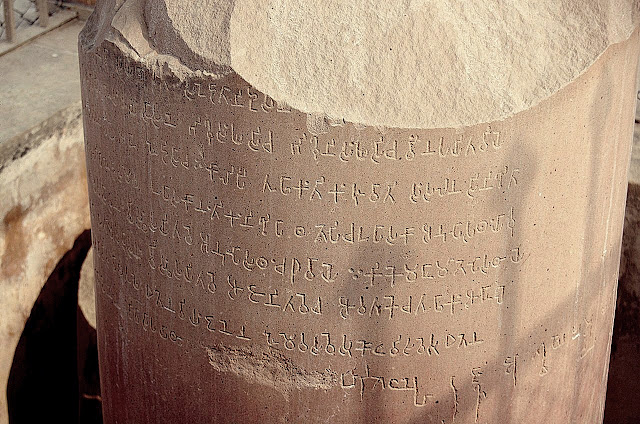Buddhism on Homo- and Transsexuality
The young man Soreyya, seeing the golden complexion of the elder monk, thought, "How I wish the elder were my wife, or else that the complexion of my wife were like that of his." As the wish arose in him, his sex changed and he became a woman. Very much ashamed, he got down from the carriage and ran away, taking the road to Taxila. —from the Dhammapada Commentary
Homosexuality and some forms of transsexuality have existed pretty much everywhere in the world, always, which includes traditional Buddhist societies. There are homosexuals and transsexuals alive today in rural Buddhist Burmese villages, for example. Such aberrations from the heterosexual biological norm are not glorified, or considered to be just as good as heterosexuality, but they are tolerated, and to some degree even respected in a compassionate sort of way.
This latter is especially true of transgender people—that is, people who identify as members of the opposite sex from their own body. It’s not extremely uncommon to see a man dressed as a woman and acting like one, or a woman dressed as a man and acting like one, more or less, even in remote, unsophisticated villages. For the most part they are allowed to do their thing, and I do not recall hearing of any of them being harassed, although I suppose it does happen occasionally.
There is some social stigma in Buddhist Burma against gayness in men, however, especially if they are of the “flaming” variety—you know, the ones who don’t walk exactly, but rather sashay, and who affect a feminine lilting tone of voice, possibly even punctuating their sentences with a momentary protrusion of the tongue. It seems to be universal throughout human societies, with few exceptions, that effeminate men are viewed as weak, timid, and inferior; and in more traditional societies in which toughness may be necessary in a man this stigma is more prevalent than in more modern, progressive, and “decadent” urban environments. Consequently gay men in Burma tend to be closeted, or gay by stealth, many of them moving to cities where they can live with less scrutiny than what prevails in a village environment, where everyone knows pretty much what everyone else is up to. Also, some of them become nat kadaw, or people supposed to be possessed by a spirit or god and who dance wildly at festivals and occasionally prophesy while supposedly possessed; academics have observed that sexually frustrated people, male and female, are most likely to become nat kadaws. It turns out to be a makeshift means of working off emotional frustrations. Also, many homosexual men (mostly latent ones) in Buddhist countries become ordained as monks as a socially acceptable way of not mating with a woman. Effeminate monks are fairly common in the more comfortable monasteries in towns, and usually stay away from the rougher, more austere forest monasteries. I suppose this is common anywhere that traditional monastic or otherwise celibate religious cultures are found, including, rather notoriously, the Roman Catholic Church in the west.
Transsexuality in particular is tolerated, even in rustic villages, partly due to the Burmese sense of community, but also because of the Buddhist belief in rebirth, or “reincarnation.” A biological woman, say, who insists that she is a man, and behaves accordingly, is considered to be a lu win zah, or a person whose karma in a past existence has caused obvious residual effects in this, their subsequent life. In other words, a transsexual is considered to be a person transitioning over the course of more than one life from one sex to the other. As a tidbit of corroborating evidence, I can say that my father, who was an amateur hypnotist familiar with past life regressions, claimed that every man he ever met who was a woman in his previous existence was, in my father’s own words, “queer as a three dollar bill.”
All this, however, represents traditional attitudes towards LG(B)T persons in a traditional Buddhist culture, not the “official,” orthodox attitude found in the Pali Tipitaka itself. The Pali texts, being directed mainly towards celibate monks, mention sexual matters relatively little, and sexual aberrations (other than celibacy) even less. I assume there is more mention of such matters in the commentarial literature, which contains more stories of everyday life in India at the time. But most of the mention of sex and gender in the texts with which I am familiar is in the Vinaya, or rules of monastic discipline.
The rules of Buddhist monastic discipline normally recognize three genders of human being: males, females, and pandaka, which usually refers to eunuchs, i.e. castrated males. As was the case in many other cultures, eunuchs in ancient India were used as slaves, sometimes as prostitutes, and tended to be of very low social status. However, the term pandaka can be applied to anybody who is not considered to be fully male or fully female, including hermaphrodites, unusually feminine men, and unusually masculine women. Consequently, homosexual men of the femme variety, or rather the ones who are at the receiving end of homosexual acts, are also considered, at least sometimes, to be pandaka, or beings somewhere intermediate between fully male and fully female. They are forbidden to be ordained as Buddhist monks, and abnormally masculine women are likewise forbidden to be ordained as nuns. Women in fact have to endure some very embarrassing questions asked of them at their ordination ceremony concerning their sexuality: if, for example, they possess an abnormally large, almost penis-like clitoris they are forbidden to be ordained as nuns—or were, as the Order of fully ordained Theravada Buddhist nuns died out hundreds of years ago—but the extinction of the Bhikkhuni Order is a whole different politically incorrect subject that I won’t pursue here. A man who occasionally screwed a eunuch at a bath house would in all probability be allowed to enter the monkhood, so long as he was a complete man with an intact pair of testicles, and so long, of course, as he refrained from sexual activity in future. But eunuchs themselves, and effeminate homosexual men, were not to be ordained. If a person lacks testicles, i.e. is physically not a complete man, then even if the ordination is performed the ceremony is invalid, and the person in question is still not a real monk. Consequently, women who identify as men will never be allowed to be ordained as monks, regardless of how politically correct it may seem at the time. An effeminate gay man who is ordained remains ordained, however, even though his ordination may be viewed as inappropriate. (I may as well add that there is a Pali term specifically for hermaphrodites, namely ubhatovyañjanaka, or “having both characteristics,” although it isn’t used much in Vinaya. People not considered fully male or fully female, for whatever reasons, are lumped together in the technical exegesis of the rules as neuter/intermediate pandakas.)
Transsexuality in the sense of being biologically a pandaka, in and of itself, is neither moral nor immoral, as morality is a matter of mental states, not the physical properties of one’s genitalia. But the fact that feminine males and “butch” females could also be called pandaka indicates that the intermediate gender was not merely physical, but also psychological. (For example, in the ancient exegesis to the rules, when discussing pandakas, there is mention of “part-time” or “occasional” pandakas, which implies more a change of mental states and actions than one of physical anatomy.) Also, for a person to be in this state was generally viewed as karmic retribution for past misdeeds, so it was seen as the result of past immorality, even though the resultant state itself was effectively morally neutral.
From the perspective of strict Buddhist ethics, practically ALL sexuality, hetero- or otherwise, is immoral, or unskillful; this is because sexual behavior increases desire and attachment, which according to the second Noble Truth of Buddhism is the cause of all suffering. Also, a person who is committed to a sexually active life tends to be more firmly bound up in Samsara. One perceived issue with gay men and eunuchs in particular, as discussed in the rules of discipline, is that they were considered much more prone to sexual licentiousness and depravity, which would be an obvious problem for a celibate monastic order. Very masculine women were seen as a similar complication for the order of nuns—they also were considered to be aggressively oversexed, or more likely to be that way anyhow. The ancient Indian belief that gay men in particular are more likely to be wantonly promiscuous and lacking in restraint is borne out by modern medical data: I have read in the Merck Manual, a physician’s diagnostic guide, that it is not uncommon for a homosexual man to have had more than one thousand sexual partners.
I implied above that a man who had indulged in a bit of buggery with a eunuch or two in the past would probably still be considered fully male and not be prohibited from ordination. This may be in part because (I’m just hypothesizing here) the Indo-European attitude towards sexuality in ancient India was similar to the Indo-European attitude in ancient Greece and Rome. I have read that neither of the classical European cultures had a concept, or a word, specifically meaning “homosexual.” Instead, especially in Roman culture, a man was considered fully masculine, even if he had sexual relations with eunuchs or teenage boys, so long as he was the one “on top” penetrating the other, which was perceived for obvious reasons to be the masculine role. The active, aggressive penetrator was the man, and the passive recipient of the penetrating phallus was playing the feminine role, and thereby viewed as less than a complete man. Apparently some variation on this kind of thinking was prevalent in ancient northern India as well, and eunuchs were available as an alternative sex object for horny males, with no more social stigma associated, or little more, than if the male were a frequenter of female prostitutes. There would still be some stigma for being immoral and sexually unrestrained, but not for being effeminate, or less than a man. This attitude very probably has something to do with the almost universal cultural phenomenon of weak, timid, “womanly” men having a lower reputation in society—especially in older, more traditional cultures. If they are seen as prone to depravity as well, then so much the worse for them.
It may be borne in mind, as a kind of extenuating circumstance, that the Buddha, although freely admitting that women are just as capable of enlightenment as men, nevertheless, according to the Pali texts, was very unwilling to allow women to be ordained as Buddhist nuns. This was for essentially the same reasons as his reported unwillingness to allow ordination of pandakas: it would increase sexual tensions in a celibate monastic order. The well-known extracurricular troubles that can arise between men and women associating together (in a religious society, an office environment, the military, whatever) are similar enough to make the troubles that can arise between sexually frustrated males and girlyboys with a reputation for licentiousness to be fairly straightforward.
So, it appears that, though all sexuality is considered vulgar, “the way of the village,” and an impediment to enlightenment by orthodox Buddhism, homosexuality, at least being at the receiving end of it, was considered worse, a kind of perversion of nature both physically and mentally, and sufficient to disqualify a man from entering the Buddhist Sangha (though historically many have done so nonetheless, as is notoriously the case with other celibate religious orders as well). Physical and innate psychological aberrations involved with transsexuality were seen more as dysfunctions than as some sort of moral defect, but transsexuals were also seen as more prone to immorality as a result of these aberrant states. So, Buddhism is much more tolerant of homosexuality and transsexuality than are traditional western monotheistic religions, as determined by their scriptures, and less absolutely black and white with regard to heaven and hell; but nevertheless, like all other major spiritual systems, Buddhism often, if not always, finds deviance from the heterosexual norm (other than celibacy of course) to be a kind of unhealthy spiritual handicap, associated with a greater likelihood of sexual immorality. So all gays, lesbians, and shemales won’t burn in hell, and some of them may even become enlightened so long as they restrain their sexual urges like any other saint; but their very state may very well be a kind of karmic retribution from misdeeds performed in some previous existence, and it is certainly nothing to be celebrated or paraded in the streets.
And so it’s not all bad for homosexuals, transsexuals, androgynes, non-binary gender queers, etc. etc., from a strictly Buddhist perspective. In Eckhart Tolle’s first famous book he declares that, in one sense at least, gays have (or used to have until recently) the spiritual advantage of being outsiders to mainstream samsaric culture, making it easier for them to have some detachment from the chronic raging insanity that prevails in the secular world. Also, one of my first spiritual guides in this life, Ram Dass, was bisexual, and evidently preferred sleeping with guys—and he was, and still is, a relatively highly spiritually advanced individual. I’ve known several homosexual Buddhist laypeople over the years, and they have not struck me as obviously inferior in their spiritual attainments to their straight peers. They seem not to be particularly handicapped in their spiritual endeavors, and it appears to be lust in general that is more of a liability than lust specifically directed towards somebody in particular.
 |
| yes, these are all allegedly biological males |







We should beware the Jewish influences that attempt to sexualize spirituality; the neighbouring tribes that later became Turks and Arabs have similar tendencies that greatly contributed to Islam and partly explain pre-Islamic Indo-Iranian phenomena.
ReplyDeleteI assume:
1) recent increase in homosexuality approx. 5000 years ago
2) homosexuality affecting now even the lower classes
So neither ancient India nor Rome can be used as role models without critical examinations. The ancient Pompeii sex art etc. are not keys to Aryan past, but windows to our present predicament.
Evola explained in The Third Sex (L'arco e la clava) that the reason why he barely touched homosexuality in Metafisica del sesso was because it's not just the bourgeois moral prejudice that categorizes it as pathological, but even a broad metaphysical understanding of sexuality.
I find particularly dangerous that concession you made towards dominating homosexual males, because that concept of domination (that is also common to some warlike Semites) skewes not just homosexuality but also healthy masculinity. Male homosexuality is always more degrading as a relationship due to the effeminate male and the shared responsibility for him that binds even the "dominating" one to the state of womanhood.
In contrast, lesbian sex "is not quite as degrading" says Evola, because the ancients knew that tota mulier sexus. ("woman is wholly sex")
Besides those cases where the residues or development clearly incline toward "natural" homosexuality, there is also the "democratic" climate that springs more cases. The root cause is a lack of central force and dominating principle on the societal (and spiritual) level, that leaves individuals vulnerable to latent possibilities; residues that in a normal civilizations would be neutralised by dominating forms outside and inside oneself [Ancient Arahants!]. Regression leaves the individual vulnerable (lacking hêgemonikon or inner sovereign) to the lower forces that can surface and produce various pathological traits like bisexual inclination.
More important things like character and personality are even more gravely affected than sexuality so I assume that the original reason for the nonadmission of the ambivalent cases has more to do with those than any Semitic unease and vacillation arising from sexual tensions.
Racial, ethnic and national degeneration gives way to shapeless and hybrid characters that influence even the constitution of the individuals on all levels, including the ontological level.
Great article with some comprehensive perspectives on paṇḍaka I hadn't read elsewhere so far, thanks Bhante!
ReplyDeleteThis comment has been removed by the author.
ReplyDelete